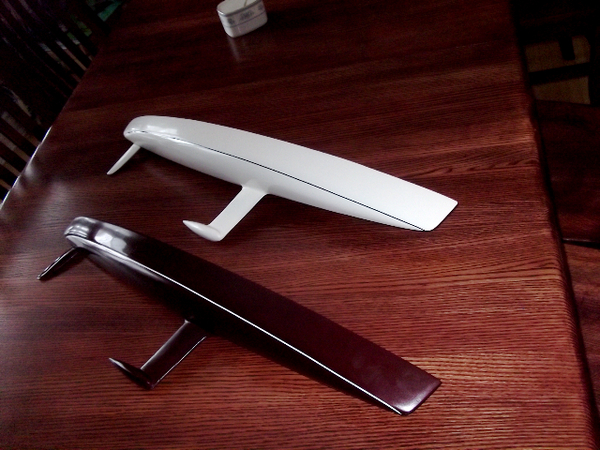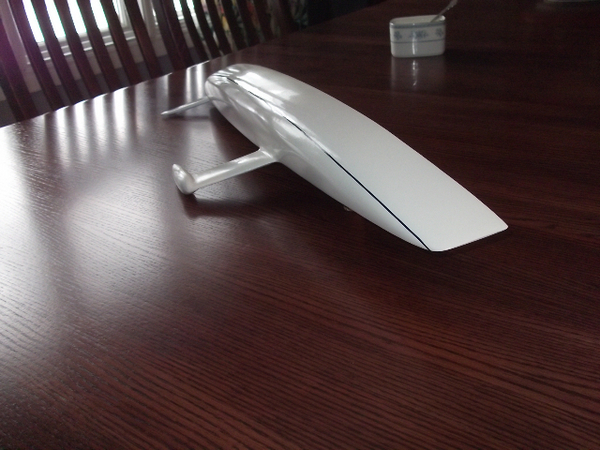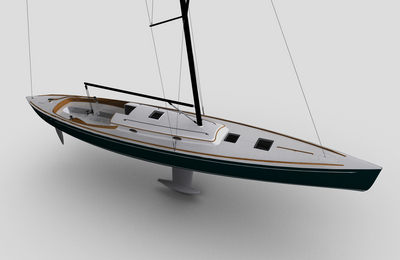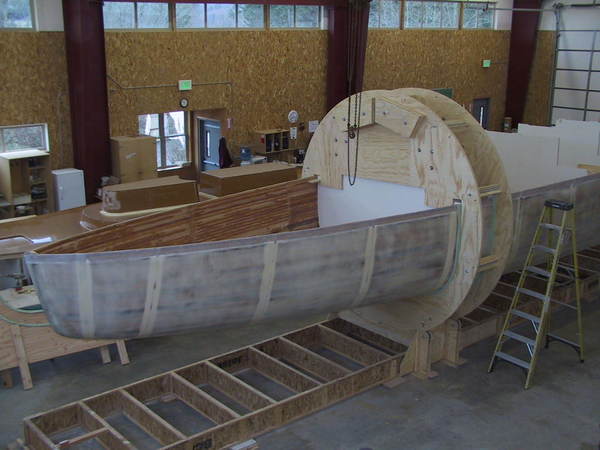There is probably no greater compliment a yacht designer can receive than being asked to design a new yacht for a friend.
When I was a kid I loved to walk the docks down at the Shilshole Bay Marina. This was back in the day before they began putting locks on the gates. I would take a sketch pad with me and stop and sketch various design details that appealed to me. I think I was 15 years old at the time, before I had a driver's license but I'd get from Mercer Island to Ballard mostly on foot. It was a good walk. I was strolling the docks one day and I came to a boat that stopped me dead in my tracks. It was long, skinny, pale green and had an amazing canoe stern. Everything about this boat was different from the other boats I had seen. Even the cabin trunk with it's raised pilot house was different. Te name on the stern was OCEANUS. I would later learn that this was Bill Garden's own boat. In time I would race on OCEANUS but then I ju
 st stood and stared. I'm not positive but it may have been that encounter with OCEANUS that started my love affair with double enders. My life at the time revolved around two things, not counting girls, yacht design and guitar playing. I was convinced I wanted to be a yacht designer. My high school geometry teacher, Don Miller, a very patient man, encouraged me to call Bill Garden. I did and arranged for a Saturday meeting at his office. Bill was gracious and generous with his time and sent me home with a big roll of prints he was probably sending of to the dumpster until I expressed an interest in them. But if I have to think of one boat that has stood out in my mind as the ultimate expression of the yacht design art I think it would be OCEANUS. Bill is gone to that big design office in the sky now and OCEANUS was broken up for scrap a bout two years ago. But long, skinny canoe sterned boats still appeal to me.
st stood and stared. I'm not positive but it may have been that encounter with OCEANUS that started my love affair with double enders. My life at the time revolved around two things, not counting girls, yacht design and guitar playing. I was convinced I wanted to be a yacht designer. My high school geometry teacher, Don Miller, a very patient man, encouraged me to call Bill Garden. I did and arranged for a Saturday meeting at his office. Bill was gracious and generous with his time and sent me home with a big roll of prints he was probably sending of to the dumpster until I expressed an interest in them. But if I have to think of one boat that has stood out in my mind as the ultimate expression of the yacht design art I think it would be OCEANUS. Bill is gone to that big design office in the sky now and OCEANUS was broken up for scrap a bout two years ago. But long, skinny canoe sterned boats still appeal to me.About a year ago I got a call from Kim. I have known Kim for years and raced and worked with his son on ATALANTA when Derek was the skipper. Kim and I share a love of the history of yacht design and we also share similar tastes in yachts. Kim had owned a K. Aage Nielsen sloop of uncommon beauty and his current boat is a 30 square meter class sloop. Kim thought it would be a good idea to get together and discuss a new boat, maybe a long, skinny double ender and I am certain OCEANUS was mentioned. Kim came up and we started chatting. The new boat would be about 60' long and would be designed as a daysailer. I pulled pout some tracing paper, I call it "flimsy" and I started sketching with Kim at my side. In very few minutes we had a profile that Kim and I liked but it was a rough start. My idea was a boat with some overhangs, not as much as OCEANUS had but enough to provide some fun in the shaping of the ends. I had this idea that I would use bow sections very similar to those on the Laurie Davidson America's Cup boat BLACK MAGIC.
 I would use that shape to help push volume into the bow in increase the prismatic coefficient and get a bow that did more than just hang out over the water. Overhangs can't just float out there. They have to be immersed at some heel angle if they are going to do any "work". Kim liked the idea. I drew a few preliminary sets of lines. Kim then sent me a copy of a Herreshoff profile of a long double ender and said, "How about this look?" The overhangs were gone. The Herreshoff boat was all waterline. I told Kim, "I can do that." I like waterline. From there things progressed rapidly. Kim and I were almost always on the same page and having a large bank of common reference design made communication easy. I think, according to my revision notes, that I drew eight preliminary hull shapes before Kim and I both agreed that we were "there". I would later make a change by adding more deadrise after Kim decided to build the hull in strip plank construction. I needed more volume below the sole for floor structure depth. The keel is a steel weldment that will double as a fuel tank with a lead bulb. The rudder is actually a rudder I did for another boat. That owner asked for a new rudder design because he did not like the first rudder. I designed him a new rudder and in the end the problem was bearings not rudder design. So we had this almost brand new carbon rudder sitting at the boatyard in California waiting for a new owner. It is perfect for Kim's boat.
I would use that shape to help push volume into the bow in increase the prismatic coefficient and get a bow that did more than just hang out over the water. Overhangs can't just float out there. They have to be immersed at some heel angle if they are going to do any "work". Kim liked the idea. I drew a few preliminary sets of lines. Kim then sent me a copy of a Herreshoff profile of a long double ender and said, "How about this look?" The overhangs were gone. The Herreshoff boat was all waterline. I told Kim, "I can do that." I like waterline. From there things progressed rapidly. Kim and I were almost always on the same page and having a large bank of common reference design made communication easy. I think, according to my revision notes, that I drew eight preliminary hull shapes before Kim and I both agreed that we were "there". I would later make a change by adding more deadrise after Kim decided to build the hull in strip plank construction. I needed more volume below the sole for floor structure depth. The keel is a steel weldment that will double as a fuel tank with a lead bulb. The rudder is actually a rudder I did for another boat. That owner asked for a new rudder design because he did not like the first rudder. I designed him a new rudder and in the end the problem was bearings not rudder design. So we had this almost brand new carbon rudder sitting at the boatyard in California waiting for a new owner. It is perfect for Kim's boat.There is really nothing special about the hull lines. With less than 18,000 lbs. displacement to work with and 62' of LOA I just pushed volume into the ends to get the Cp up and I made the turn of the bilge firm aft. There are no hollows in the shape. The sheer is a bit flat but with a narrow boat more spring in the sheer would look odd. I do have to ad
 mit that when you enter the boatyard you have to look hard to tell which end is the bow and which is the stern. In the photos of the boat in the hop the stern is closest to the camera. Dan Faulkner, my good pal aka Gatekeeper, has made two very beautiful half models, one for Kim and one for me. For more information on Dan's model making go to
mit that when you enter the boatyard you have to look hard to tell which end is the bow and which is the stern. In the photos of the boat in the hop the stern is closest to the camera. Dan Faulkner, my good pal aka Gatekeeper, has made two very beautiful half models, one for Kim and one for me. For more information on Dan's model making go toKim did not care much about the interior of the boat. It was a daysailer and simplicity was the key. But I couldn't help thinking that if it were my boat I would want some comfort below for cruising. I also had the idea that we could use interior joinery as structural members to give our long, skinny boat some longitudinal stiffness. I drew an ultra simple layout with a rudimentary galley, using Igloo coolers for reefers, comfortable settee berths in the salon, a usable head forward and a big queen sized double berth forward. The front of the settees, counters and lockers forward are all one long longitudinal stiffener. Headroom stops at the forward end of the head. That was essential to preserving the look of the boat.
The real focus of the boat is the cockpit. The SLIVER will be tiller steered with the mainsheet directly forward of the helmsman's position. We will use a rigid vang and we will not have a mainsheet traveler. The cockpit seats are long and the seatbacks are high for comfort. Here is a rendering of the SLIVER done my good pal Rick Beddoe aka Sons aka Sonadora. This is an early rendering and the keel geometry has been changed.

I had a very distinct rig in mind based upon the rig geometry of the 30 Square Meter Class boats. This would be a fractional rig with the hounds at about 72%. I drew it and it looked sexy. I even drew exaggerated bend to the upper portion of the mast, just like the 30 Square Meters have. I loved it. The sailmakers hated it. The spar maker hated it. I could tell that I was in for a right good beating then something happened that changed the entire approach to the rig. Bob Pistay, a Seattle sailmaker, suggested we look at a used carbon Farr 40 rig.
 I called the Farr office and they very graciously provided me with complete drawings for the Farr 40 rig. They are very nice guys. I copied the Farr 40 rig onto the SLIVER and the fit was near perfect. Of course I lost my silly long "topmast" and my exaggerated bend at the top was eliminated but the rig fit, gave us the sail area we were after and did it at a tremendous cost savings over an entirely new rig. When you look at the sail plan it looks like a tiny rig on a big boat. But the SLIVER is not a big boat. It's a long boat. And, that rig is enough for a SA/D of 22.78. SLIVER at less than 18,000 lbs. has more sail area than a Valiant 40 at, let's be honest, 27,000 lbs.. If you like those ratios the D/L for the SLIVER is 49 and that is very low.
I called the Farr office and they very graciously provided me with complete drawings for the Farr 40 rig. They are very nice guys. I copied the Farr 40 rig onto the SLIVER and the fit was near perfect. Of course I lost my silly long "topmast" and my exaggerated bend at the top was eliminated but the rig fit, gave us the sail area we were after and did it at a tremendous cost savings over an entirely new rig. When you look at the sail plan it looks like a tiny rig on a big boat. But the SLIVER is not a big boat. It's a long boat. And, that rig is enough for a SA/D of 22.78. SLIVER at less than 18,000 lbs. has more sail area than a Valiant 40 at, let's be honest, 27,000 lbs.. If you like those ratios the D/L for the SLIVER is 49 and that is very low.Choosing a builder is always very serious business. Kim and I discussed various ways the boat could be built. Kim liked the idea of a wooden boat. I liked the idea of a composite boat. After discussing the project with several builders Kim settled on building the boat at the Northwest School of Wooden Boatbuild
 ing in Hadlock Washington., not too far from where Kim lives. Kim and I both got our construction preferences. The hull would be strip planked with cedar and the deck would be composite and come out of a one off female mold. The hull will be sheathed in Vectorply E-TLX 2400-10 triaxial cloth. Kim really liked the idea that the boat was going to be built locally with local help. For the engineering of the new boat we went to Tim Nolan and Jim Franken. They have an office in Port Townsend 15 minutes away from the boatyard. I had not worked with Tim or Jim before but I had been very aware of their work, usually in large powerboats. Tim does the engineering and Jim does all the amazing 3d modeling work we have used for all the stages of construction including the design of the rollover jig with CNC cutting by Brandon Davis of Port Townsend. The project is benefiting from a highly skilled team of local craftsmen. The stem and stern post were CNC cut and added after the planking was completed. The female deck mold is complete ( you can just see it behind the hull) and the deck will soon be laminated.
ing in Hadlock Washington., not too far from where Kim lives. Kim and I both got our construction preferences. The hull would be strip planked with cedar and the deck would be composite and come out of a one off female mold. The hull will be sheathed in Vectorply E-TLX 2400-10 triaxial cloth. Kim really liked the idea that the boat was going to be built locally with local help. For the engineering of the new boat we went to Tim Nolan and Jim Franken. They have an office in Port Townsend 15 minutes away from the boatyard. I had not worked with Tim or Jim before but I had been very aware of their work, usually in large powerboats. Tim does the engineering and Jim does all the amazing 3d modeling work we have used for all the stages of construction including the design of the rollover jig with CNC cutting by Brandon Davis of Port Townsend. The project is benefiting from a highly skilled team of local craftsmen. The stem and stern post were CNC cut and added after the planking was completed. The female deck mold is complete ( you can just see it behind the hull) and the deck will soon be laminated.
Not sure what else there is to say about the SLIVER project. So far it has been a lot of fun. Kim visits the shop frequently and I go over once and a while just to admire the work. I have a picture in my mind of the SLIVER sliding along effortlessly and silently in the light PNW breeze. I think it will make a gentle hissing sound. Kim will be at the tiller with a very contented look on his face. I'll be on the beach silently telling myself, "You did good Bob. You didn't turn out just like Uncle Mick."

No comments:
Post a Comment